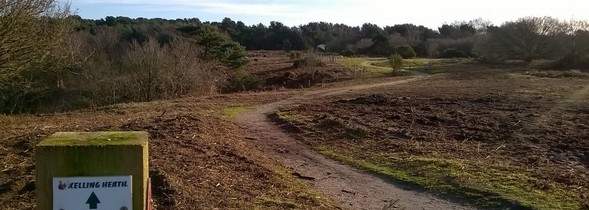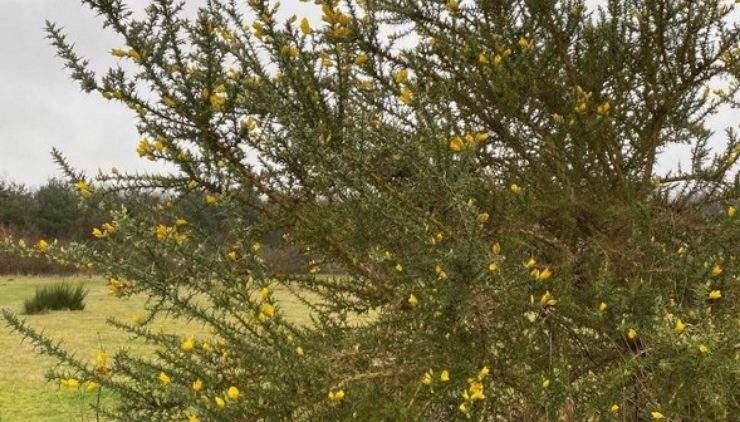Heathland and Ponds update
- Categories:
- Nature

Kelling Heath Holiday Park is on a 300 acre estate made-up of woodland, grassland and very rare lowland heathland, all enjoyed by thousands of visitors every year. There is a constant need to preserve, protect, and sometimes enhance the natural environment across the estate, and so a four man team of Countryside Rangers is employed by the holiday park to ensure this happens.
This winter the Countryside Rangers have been focusing on two extremes of habitat, both of which exist on the Park, the ponds and wetlands, and the dry lowland heath.
With a name like Kelling Heath Holiday Park it could be assumed that the land across the estate is reasonably dry. However, there are two good sized ponds along with a wetland and natural spring. This natural spring runs across the wetland and feeds one of the ponds known as the Fishing Pond. The source of the spring can be seen from the boardwalk that hovers across part of the wetland. The second pond is found on the edge of some semi-ancient woodland called Hundred Acre Woods. This pond is known as the Conservation Pond.
This winter the Rangers have been busy on both the ponds. Five new fishing platforms have been built on the Fishing Pond. The dominant vegetation growing around the edges of the pond have been dramatically reduced to allow other species to grow and so increasing the diversity of the flora and fauna. The reed bed and waterlilies growing in the pond have been reduced slightly in order to improve the recreational value of the Fishing Pond. On the Conservation Pond work has been carried out to protect the edges of the pond from erosion and to control some of the dominant aquatic vegetation which was starting to have a detrimental effect on the really rare and interesting native species which exist. Forty Crucian Carp, which are a native but endangered fish, have just been introduced to this pond to help with a national breeding program. The resident Moore Hens and the large Sweet Chestnut tree growing out of the Conservation Pond, which is iconic to the Park, have remained untouched.
Now that this work has been completed the ponds and wetlands can yet again play host to bats hunting moths, birds building nests, dragonflies mating, froglets marching, deer grazing, as well as, pond dippers, fisherman, walkers, cyclists and much more.
Once the wet bits were all in order the Rangers headed over to the lowland heathland. Here the land is always trying to turn into woodland. However, lowland heathland is a very rare habitat and lots of rare and interesting wildlife relies on it. It has always existed on some of the Parks estate and the land heading across to Kelling Village because of the soils lack of nutrients and high acidity. For this reason it was never used as arable land or converted to grassland, but instead was grazed in its natural condition. This stopped the native heathers, which were left by the grazing animals, being out-competed by tree species which were also able to grow in the poor soils. Tree growth was also controlled on the heathland by people harvesting the trees for fuel or for building materials. Grazing on the heathland stopped many years ago as did large scale tree harvesting.
The lowland heathland on both the holiday park estate and on the neighbouring land has since been kept in reasonable condition by rotational cutting using tractor mounted machines, which can both cut and pick-up the encroaching vegetation. This method proves quite successful in some areas but less so in others, and some of these poorer areas of heathland are the ones being targeted by the Countryside Rangers this winter. This is involving removing encroaching vegetation with chainsaws and in some cases mini-diggers. All the cut and dug-up vegetation is then removed off the heathland. Sometimes this work is exposing good bits of heather growth but often the encroaching vegetation has long since out-competed and killed it. When the latter is the case the Rangers are trialling a heathland management method which has not been used on the estate before. They are lightly drilling the soil to turn the part contaminated with seed from encroaching vegetation over in order to expose heather seed rich soil. In other areas where there is a good covering of native heathers, but where the plants are very old, some cutting has already taken place. This cutting was done back in autumn last year for two reasons. The first was to encourage fresh grow on the old plants, and the second was so the seed-rich cuttings could be used in a heathland creation project happening in another part of the estate.
The Countryside Rangers have also remembered lessons from the past and reintroduced grazing to a part of the heathland. This grazing is being carried out by a flock of Black Welsh Mountain sheep. Some of these sheep are veterans in conservation, having previously worked on important areas of the Brecks.
The heathland work for the holiday park's Countryside Rangers does not stop there. They are now helping to support the work being carried out on the neighbouring land. This land has a Site of Special Scientific Interest designation placed on it, meaning it is one of the country's best and most important sites for wildlife and geology. The land management operations being carried out on this part of the heathland by the Park's Rangers are controlled by Natural England and a group of trustees.
Once this year's heathland work is done it will ensure that the habitat so important to rare species like, for example, the Adder and Nightjar, is preserved. The work will also have aesthetical implications to the Park and the dramatic views enjoyed by the holiday park of sea, sky, trees and countryside will be even more impressive.


